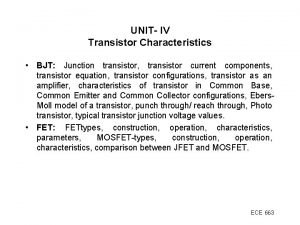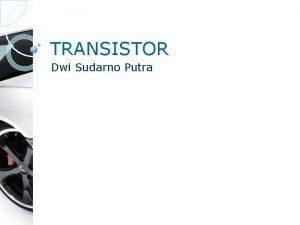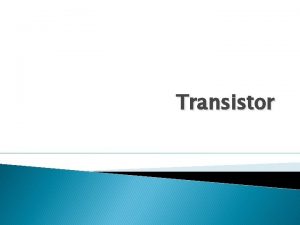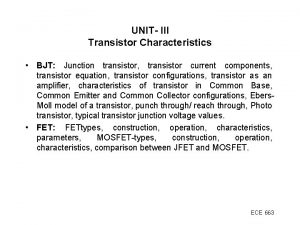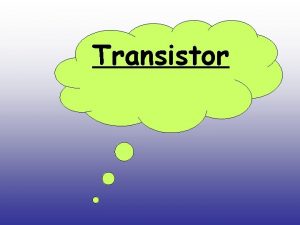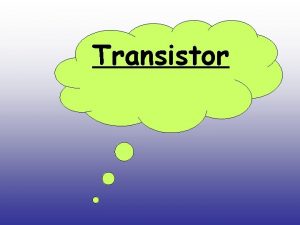WELCOME TO MY PRESENTATION TOPIC Transistor as an










![Calculations[Cont. ] • Therefore, Av=-BACRc/RB (‘-’ sign indicates 180 phase shift) • Hence, we Calculations[Cont. ] • Therefore, Av=-BACRc/RB (‘-’ sign indicates 180 phase shift) • Hence, we](https://slidetodoc.com/presentation_image_h/2dc223ee2604234ad6926b0d8a72c9a3/image-11.jpg)



- Slides: 14

WELCOME TO MY PRESENTATION TOPIC – Transistor as an Amplifier

Contents • • • Introduction What is Transistor? Transistor Symbols Applications of Transistor Working of Transistor as an Amplifier How Transistor Works as an Amplifier? Examples Calculations Reference Conclusion

Introduction * The goal of this presentation is to learn basics of Transistor as an Amplifier, its working, method, calculations etc. • Well, I have chosen this topic to enhance my concepts of Transistor and boost my technical skills. • The following presentation should be a good start for all of you too. So, let see upcoming slides for more details.

What is Transistor? A transistor is a semiconductor device used to amplify or switch electronic signals and electrical power. It is composed of semiconductor material usually with at least three terminals for connection to an external circuit.

Transistor Symbol

Amplification Applications of TRANSISTOR Switching

Working of Transistor as an Amplifier • Transistor can operate in three different regions viz. , cutoff, active and saturation. • Transistors are fully-off in cut-off region while fully-on when operating in saturation region. • However, while they operate in active region, they act as amplifiers i. e. they can be used to increase the strength of the input signal without altering it significantly.

How Transistor Works as an Amplifier


Calculations • ∆IB=(20 -10) u. A =10 u. A • ∆Ic=(4 -2) m. A =2 m. A • Current Amplification Factor, BAC= ∆Ic/ ∆IB=200 • Voltage Amplification , Av= ∆Vo/ ∆Vi • Applying KVL in input and output loop, ∆Vi= ∆VBB and ∆Vo=-Ic. Rc
![CalculationsCont Therefore AvBACRcRB sign indicates 180 phase shift Hence we Calculations[Cont. ] • Therefore, Av=-BACRc/RB (‘-’ sign indicates 180 phase shift) • Hence, we](https://slidetodoc.com/presentation_image_h/2dc223ee2604234ad6926b0d8a72c9a3/image-11.jpg)
Calculations[Cont. ] • Therefore, Av=-BACRc/RB (‘-’ sign indicates 180 phase shift) • Hence, we can change value of Av by changing Rc and RB • Power Amplification, Ap=Voltage Amplification X Current Amplification=-BAC^2 x Rc/RB • We use capacitor here to remove DC currents and only allow AC to flow

Reference * Content Source 1. Electrical 4 U. com * Image Source 1. Google Images 2. Youtube. com

Conclusion We are now at the end of the presentation. I have tried my best to deliver the content in easy manner. Hope your concept regarding transistor as an amplifier are more clear now and enjoyed my presentation. Good luck and have a great day ahead!

Thank You
 Paragraph writing strategies
Paragraph writing strategies /topic/ down
/topic/ down Welcome welcome this is our christmas story
Welcome welcome this is our christmas story Topics for powerpoint presentation for class 4
Topics for powerpoint presentation for class 4 Powerpoint presentation on topic music
Powerpoint presentation on topic music World university of bangladesh
World university of bangladesh Assaignment
Assaignment Welcome to my presentation
Welcome to my presentation Maijdee balika bidyaniketan
Maijdee balika bidyaniketan Good morning campers today's challenge is simple
Good morning campers today's challenge is simple Hello everyone welcome to my presentation
Hello everyone welcome to my presentation Assignment point.com
Assignment point.com Welcome to my presentation
Welcome to my presentation Welcome to my presentation
Welcome to my presentation Welcome my presentation
Welcome my presentation















